ACURA NSX 1991 Service Repair Manual
Manufacturer: ACURA, Model Year: 1991, Model line: NSX, Model: ACURA NSX 1991Pages: 1640, PDF Size: 60.48 MB
Page 1111 of 1640
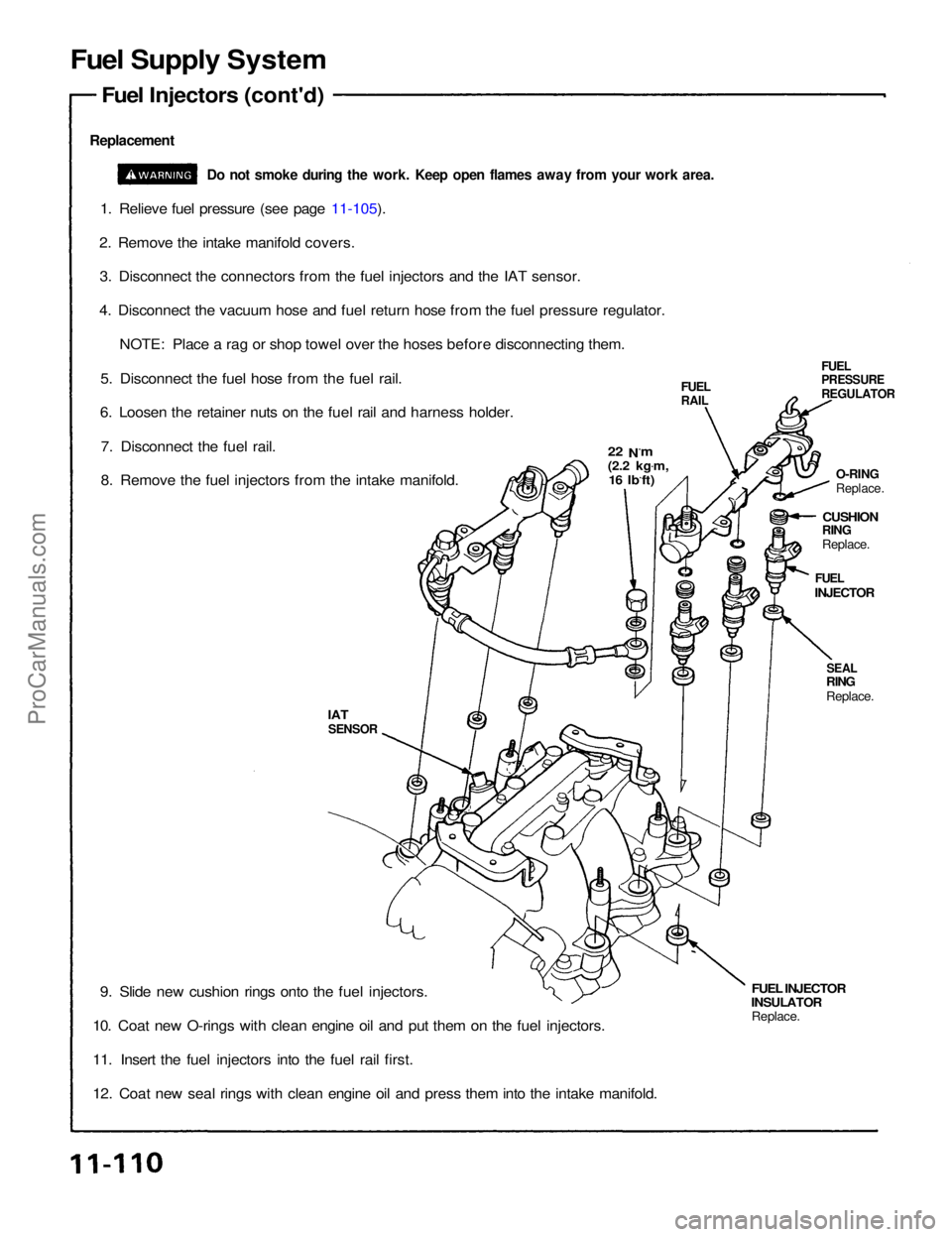
Fuel Supply System
Fuel Injectors (cont'd)
Replacement
Do not smoke during the work. Keep open flames away from your work area.
1. Relieve fuel pressure (see page 11-105).
2. Remove the intake manifold covers. 3. Disconnect the connectors from the fuel injectors and the IAT sensor.
4. Disconnect the vacuum hose and fuel return hose from the fuel pressure regulator. NOTE: Place a rag or shop towel over the hoses before disconnecting them.
5. Disconnect the fuel hose from the fuel rail.
6. Loosen the retainer nuts on the fuel rail and harness holder.
7. Disconnect the fuel rail.
8. Remove the fuel injectors from the intake manifold.
FUEL
PRESSURE
REGULATOR
22 N.m
(2.2 kg .
m,
16 Ib.ft)
FUEL
RAIL
O-RING
Replace.
CUSHION
RING
Replace.
FUEL
INJECTOR
SEAL
RING
Replace.
FUEL INJECTOR
INSULATOR
Replace.
IAT
SENSOR
9. Slide new cushion rings onto the fuel injectors.
10. Coat new O-rings with clean engine oil and put them on the fuel injectors.
11. Insert the fuel injectors into the fuel rail first.
12. Coat new seal rings with clean engine oil and press them into the intake manifold.ProCarManuals.com
Page 1112 of 1640
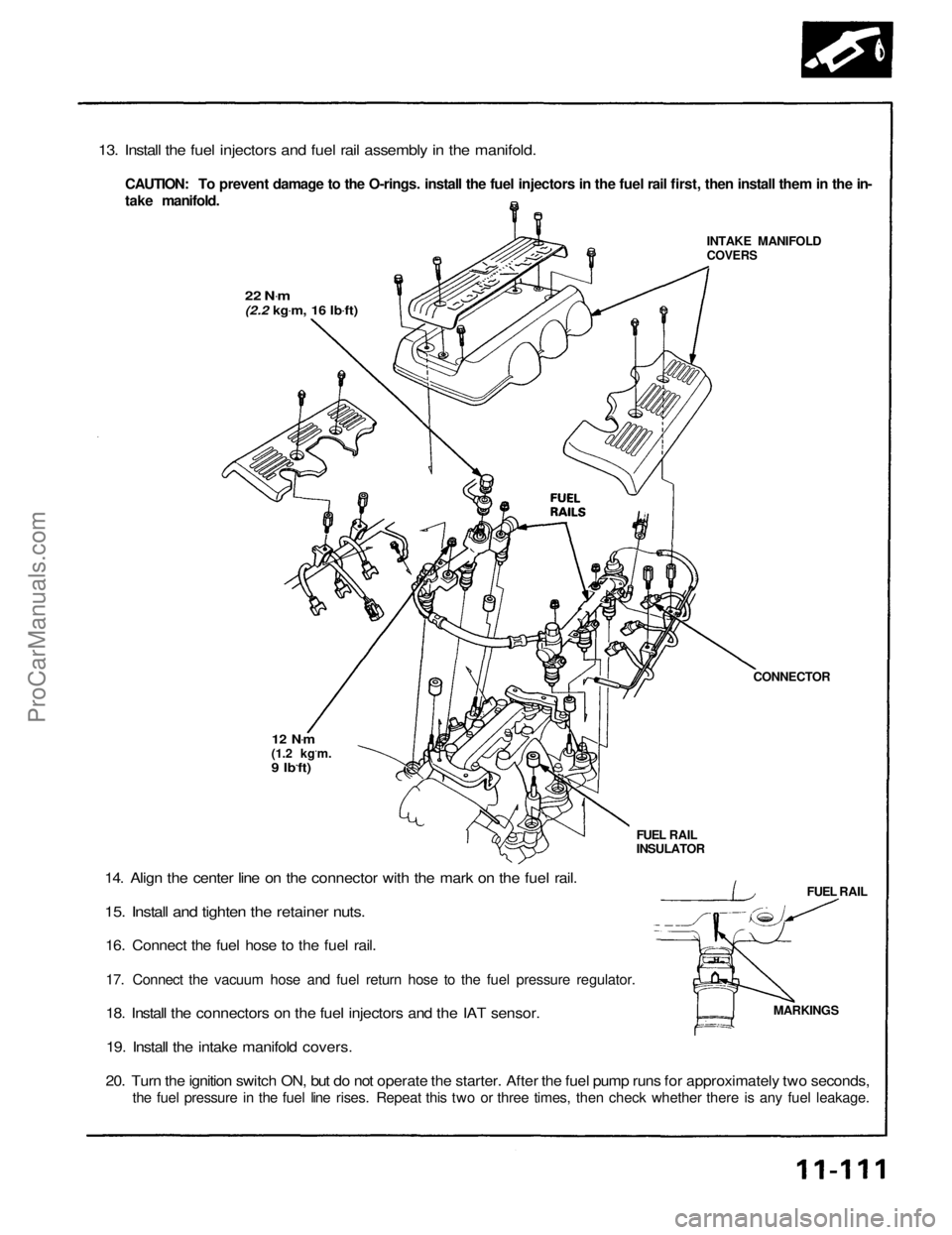
13. Install the fuel injectors and fuel rail assembly in the manifold.
CAUTION: To prevent damage to the O-rings. install the fuel injectors in the fuel rail first, then install them in the in-
take manifold.
INTAKE MANIFOLD
COVERS
22 N .
m
(2.2 kg .
m, 16 Ib .
ft)
CONNECTOR
FUEL RAIL
INSULATOR FUEL RAIL
MARKINGS
12 N
.
m
(1.2 kg.m.
9 Ib.ft)
14. Align the center line on the connector with the mark on the fuel rail.
15. Install and tighten the retainer nuts.
16. Connect the fuel hose to the fuel rail.
17. Connect the vacuum hose and fuel return hose to the fuel pressure regulator.
18. Install the connectors on the fuel injectors and the IAT sensor.
19. Install the intake manifold covers.
20. Turn the ignition switch ON, but do not operate the starter. After the fuel pump runs for approximately two seconds,
the fuel pressure in the fuel line rises. Repeat this two or three times, then check whether there is any fuel leakage.ProCarManuals.com
Page 1113 of 1640
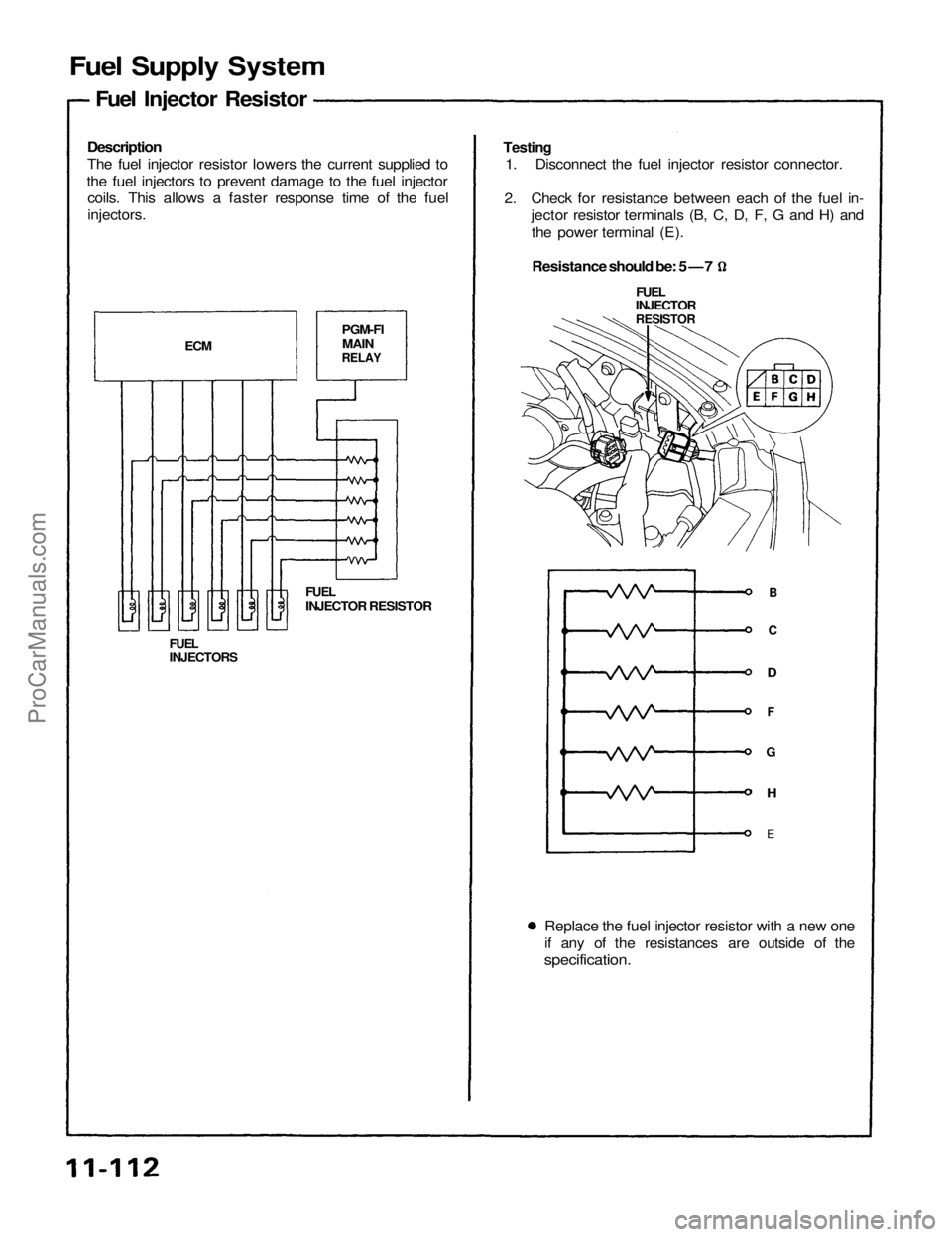
Fuel Supply System
Fuel Injector Resistor
Description
The fuel injector resistor lowers the current supplied to
the fuel injectors to prevent damage to the fuel injector
coils. This allows a faster response time of the fuel
injectors.
ECM
PGM-FI
MAIN
RELAY
Testing
1. Disconnect the fuel injector resistor connector.
2. Check for resistance between each of the fuel in-
jector resistor terminals (B, C, D, F, G and H) and
the power terminal (E).
Resistance should be: 5—7
FUEL
INJECTOR
RESISTOR
B
C
D
F
G
H
E
Replace the fuel injector resistor with a new one
if any of the resistances are outside of the
specification.
FUEL
INJECTOR RESISTOR
FUEL
INJECTORSProCarManuals.com
Page 1114 of 1640
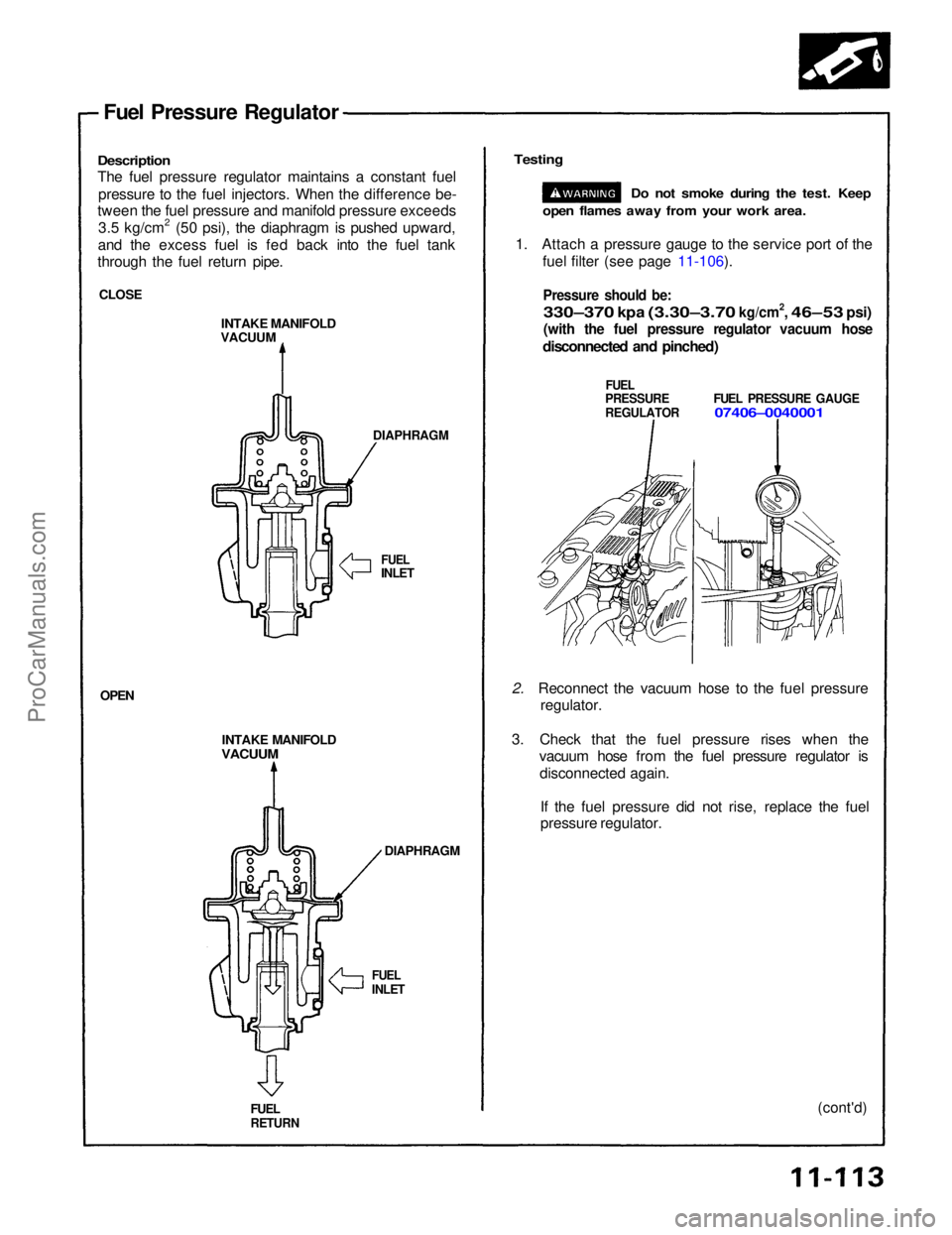
Fuel Pressure Regulator
Description
The fuel pressure regulator maintains a constant fuel pressure to the fuel injectors. When the difference be-
tween the fuel pressure and manifold pressure exceeds
3.5 kg/cm2 (50 psi), the diaphragm is pushed upward,
and the excess fuel is fed back into the fuel tank
through the fuel return pipe.
CLOSE INTAKE MANIFOLD
VACUUM
DIAPHRAGM
FUEL
INLET
INTAKE MANIFOLD
VACUUM
DIAPHRAGM
OPEN
FUEL
RETURN
FUEL
INLET
(cont'd)
2. Reconnect the vacuum hose to the fuel pressure
regulator.
3. Check that the fuel pressure rises when the vacuum hose from the fuel pressure regulator is
disconnected again.
If the fuel pressure did not rise, replace the fuel
pressure regulator.
Testing
Do not smoke during the test. Keep
open flames away from your work area.
1. Attach a pressure gauge to the service port of the fuel filter (see page 11-106).
Pressure should be:
330–370
kpa
(3.30–3.70
kg/cm2,
46–53
psi)
(with the fuel pressure regulator vacuum hose
disconnected and pinched)
FUEL
PRESSURE FUEL PRESSURE GAUGE
REGULATOR
07406–0040001ProCarManuals.com
Page 1115 of 1640
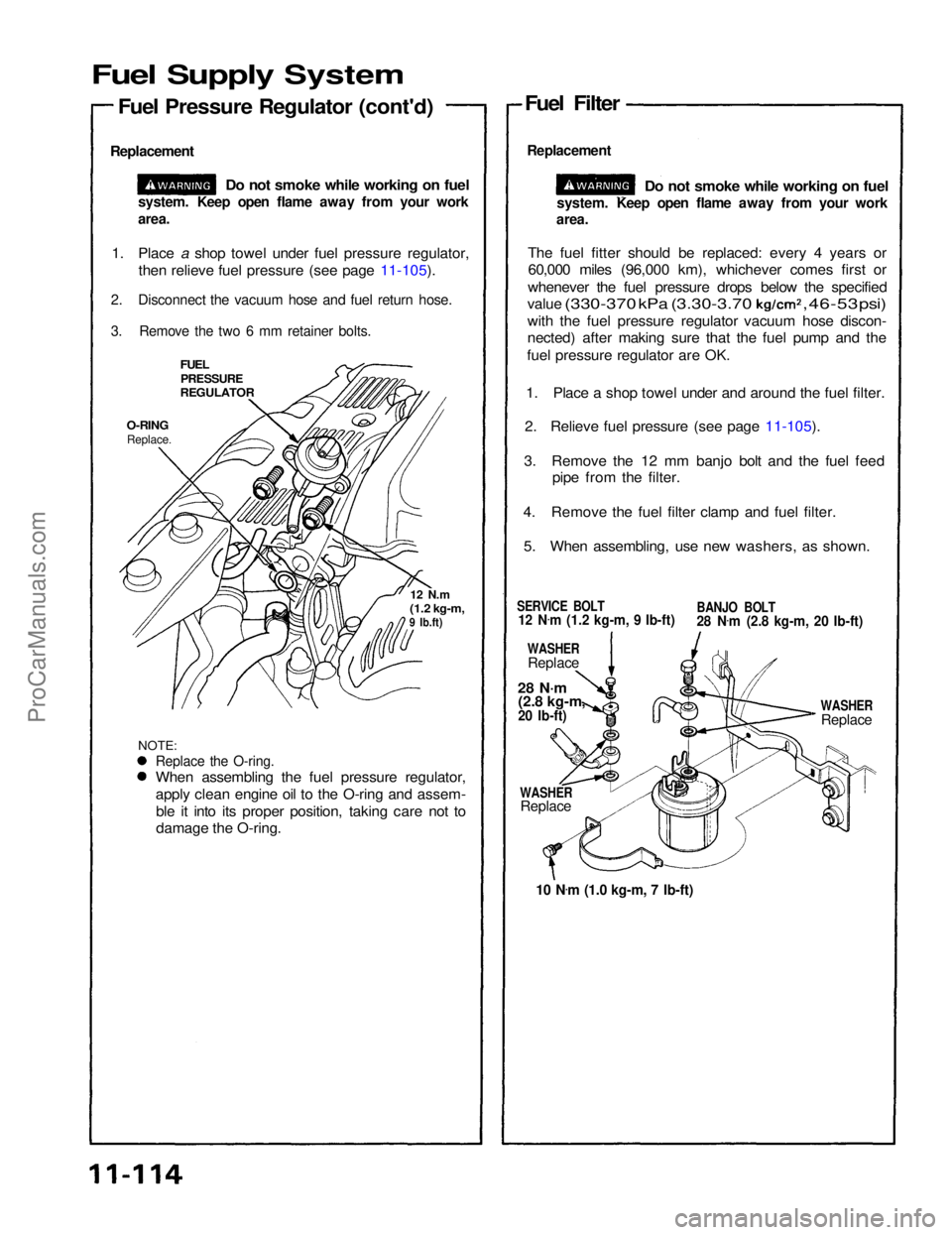
Fuel Supply System
Fuel Pressure Regulator (cont'd)
Replacement
Do not smoke while working on fuel Fuel Filter
Replacement
Do not smoke while working on fuel
The fuel fitter should be replaced: every 4 years or 60,000 miles (96,000 km), whichever comes first or
whenever the fuel pressure drops below the specified value
(330-370
kPa
(3.30-3.70
,
46-53
psi)
with the fuel pressure regulator vacuum hose discon-
nected) after making sure that the fuel pump and the
fuel pressure regulator are OK.
1. Place a shop towel under and around the fuel filter.
2. Relieve fuel pressure (see page 11-105).
3. Remove the 12 mm banjo bolt and the fuel feed pipe from the filter.
4. Remove the fuel filter clamp and fuel filter. 5. When assembling, use new washers, as shown.
1. Place a shop towel under fuel pressure regulator,
then relieve fuel pressure (see page 11-105).
2. Disconnect the vacuum hose and fuel return hose.
3. Remove the two 6 mm retainer bolts.
FUEL
PRESSURE
REGULATOR
O-RING
Replace.
NOTE:
12 N.m
(1.2 kg-m,
9 Ib.ft)
SERVICE BOLT
12 N .
m (1.2 kg-m, 9 Ib-ft)
BANJO BOLT
28 N
.
m (2.8 kg-m, 20 Ib-ft)
WASHER
Replace
28 N·m
(2.8 kg-m,
20 Ib-ft)
WASHER
Replace
10 N .
m (1.0 kg-m, 7 Ib-ft)
WASHER
Replace
system. Keep open flame away from your work
area.
system. Keep open flame away from your work
area.
Replace the O-ring.
When assembling the fuel pressure regulator,
apply clean engine oil to the O-ring and assem-ble it into its proper position, taking care not to
damage the O-ring.ProCarManuals.com
Page 1116 of 1640
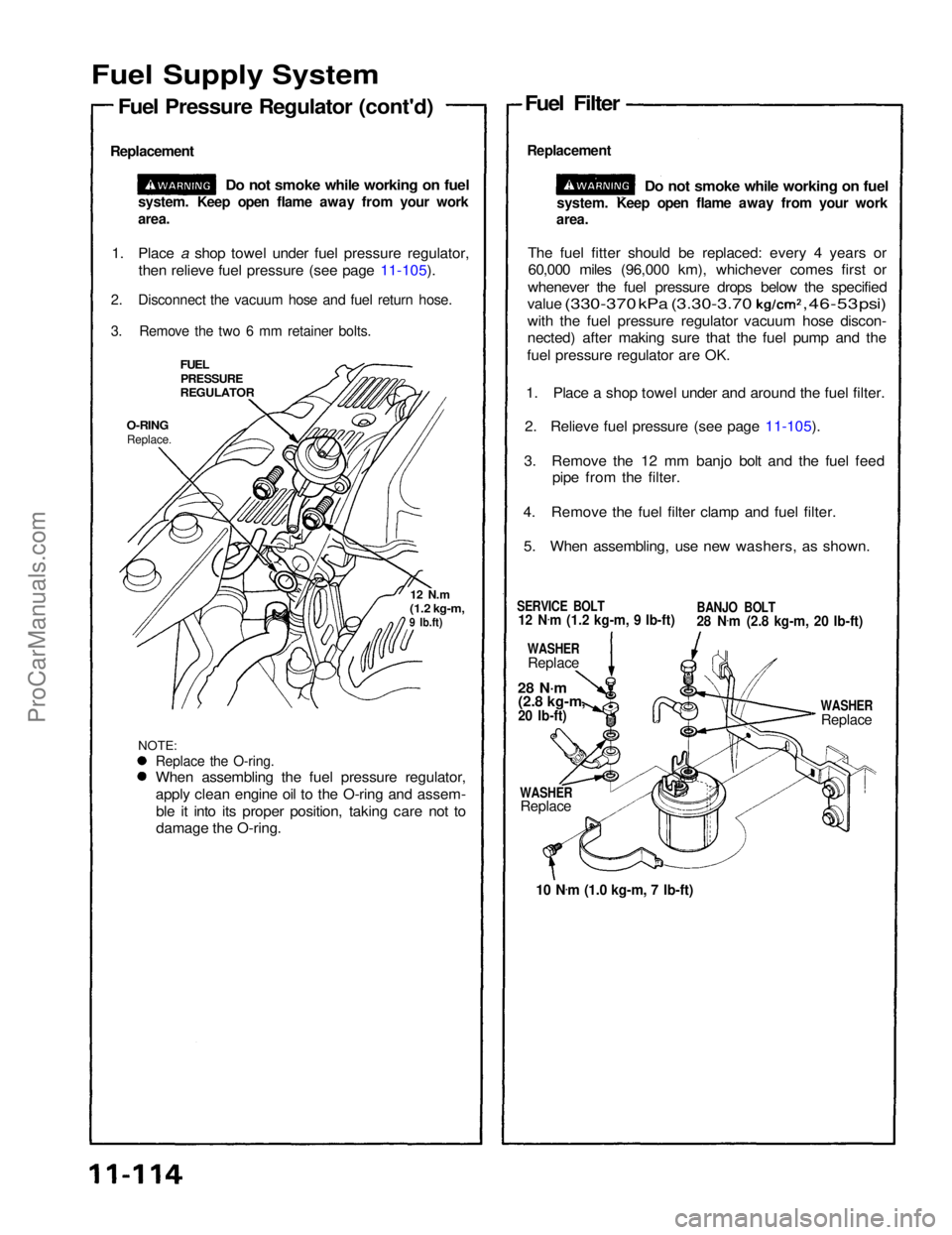
Fuel Supply System
Fuel Pressure Regulator (cont'd)
Replacement
Do not smoke while working on fuel Fuel Filter
Replacement
Do not smoke while working on fuel
The fuel fitter should be replaced: every 4 years or 60,000 miles (96,000 km), whichever comes first or
whenever the fuel pressure drops below the specified value
(330-370
kPa
(3.30-3.70
,
46-53
psi)
with the fuel pressure regulator vacuum hose discon-
nected) after making sure that the fuel pump and the
fuel pressure regulator are OK.
1. Place a shop towel under and around the fuel filter.
2. Relieve fuel pressure (see page 11-105).
3. Remove the 12 mm banjo bolt and the fuel feed pipe from the filter.
4. Remove the fuel filter clamp and fuel filter. 5. When assembling, use new washers, as shown.
1. Place a shop towel under fuel pressure regulator,
then relieve fuel pressure (see page 11-105).
2. Disconnect the vacuum hose and fuel return hose.
3. Remove the two 6 mm retainer bolts.
FUEL
PRESSURE
REGULATOR
O-RING
Replace.
NOTE:
12 N.m
(1.2 kg-m,
9 Ib.ft)
SERVICE BOLT
12 N .
m (1.2 kg-m, 9 Ib-ft)
BANJO BOLT
28 N
.
m (2.8 kg-m, 20 Ib-ft)
WASHER
Replace
28 N·m
(2.8 kg-m,
20 Ib-ft)
WASHER
Replace
10 N .
m (1.0 kg-m, 7 Ib-ft)
WASHER
Replace
system. Keep open flame away from your work
area.
system. Keep open flame away from your work
area.
Replace the O-ring.
When assembling the fuel pressure regulator,
apply clean engine oil to the O-ring and assem-ble it into its proper position, taking care not to
damage the O-ring.ProCarManuals.com
Page 1117 of 1640
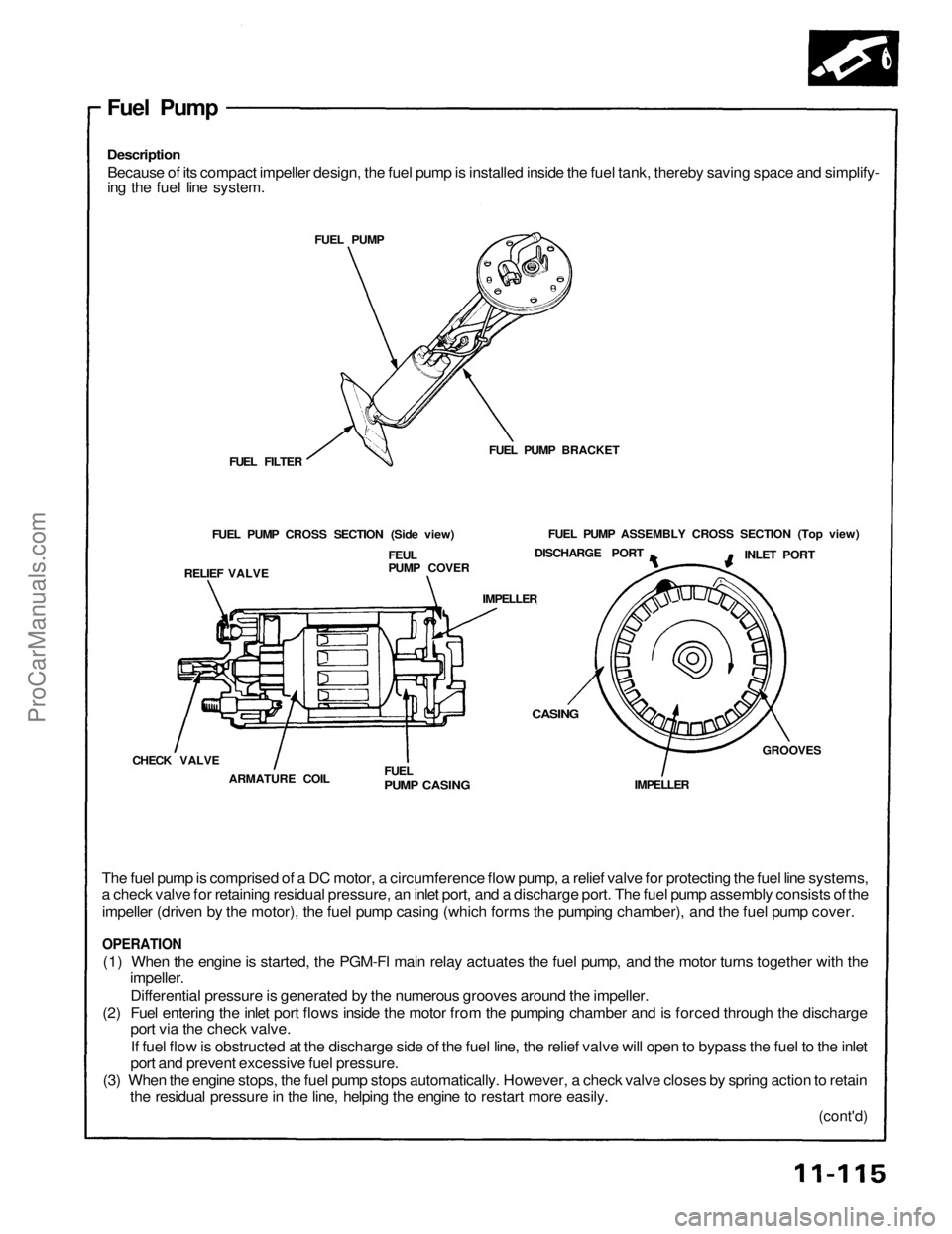
Fuel Pump
Description
Because of its compact impeller design, the fuel pump is installed inside the fuel tank, thereby saving space and simplify-
ing the fuel line system.
FUEL PUMP
FUEL PUMP BRACKET
FUEL FILTER
FUEL PUMP CROSS SECTION (Side view)
RELIEF VALVE
FEUL
PUMP COVER
FUEL PUMP ASSEMBLY CROSS SECTION (Top view)
DISCHARGE PORT
INLET PORT
IMPELLER
CHECK VALVE
ARMATURE COIL
FUEL
PUMP CASING
IMPELLER
GROOVES
CASING
The fuel pump is comprised of a DC motor, a circumference flow pump, a relief valve for protecting the fuel line systems,
a check valve for retaining residual pressure, an inlet port, and a discharge port. The fuel pump assembly consists of the
impeller (driven by the motor), the fuel pump casing (which forms the pumping chamber), and the fuel pump cover.
OPERATION
(1) When the engine is started, the PGM-FI main relay actuates the fuel pump, and the motor turns together with the
impeller.
Differential pressure is generated by the numerous grooves around the impeller.
(2) Fuel entering the inlet port flows inside the motor from the pumping chamber and is forced through the discharge
port via the check valve.
If fuel flow is obstructed at the discharge side of the fuel line, the relief valve will open to bypass the fuel to the inlet
port and prevent excessive fuel pressure.
(3) When the engine stops, the fuel pump stops automatically. However, a check valve closes by spring action to retain
the residual pressure in the line, helping the engine to restart more easily.
(cont'd)ProCarManuals.com
Page 1118 of 1640
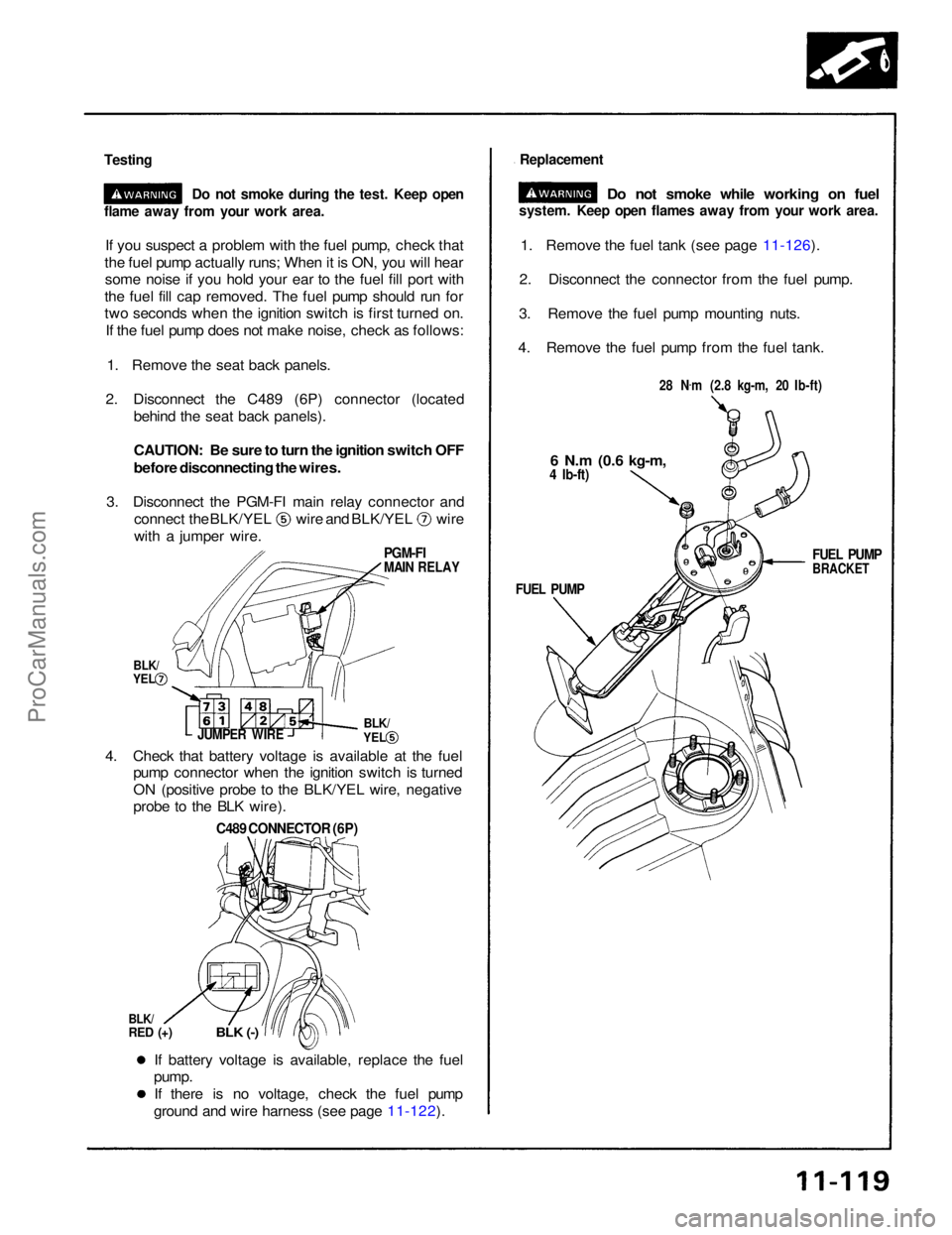
Testing
Do not smoke during the test. Keep open
If you suspect a problem with the fuel pump, check that
the fuel pump actually runs; When it is ON, you will hear some noise if you hold your ear to the fuel fill port with
the fuel fill cap removed. The fuel pump should run for
two seconds when the ignition switch is first turned on. If the fuel pump does not make noise, check as follows:
1. Remove the seat back panels.
2. Disconnect the C489 (6P) connector (located behind the seat back panels).
CAUTION: Be sure to turn the ignition switch OFF
before disconnecting the wires.
3. Disconnect the PGM-FI main relay connector and connect the BLK/YEL wire and BLK/YEL wire
with a jumper wire.
1. Remove the fuel tank (see page 11-126).
2. Disconnect the connector from the fuel pump.
3. Remove the fuel pump mounting nuts.
4. Remove the fuel pump from the fuel tank.
If battery voltage is available, replace the fuel
pump.
If there is no voltage, check the fuel pump
ground and wire harness (see page 11-122).
4. Check that battery voltage is available at the fuel
pump connector when the ignition switch is turned
ON (positive probe to the BLK/YEL wire, negative
probe to the BLK wire).
C489 CONNECTOR (6P)
BLK/
RED (+)
BLK (-)
JUMPER WIRE
flame away from your work area.
Replacement
Do not smoke while working on fuel
system. Keep open flames away from your work area.
28 N.
m (2.8 kg-m, 20 Ib-ft)
6 N.m
(0.6 kg-m,
4 Ib-ft)
FUEL PUMP
BRACKET
FUEL PUMP
PGM-FI
MAIN RELAY
BLK/
YEL
BLK/
YELProCarManuals.com
Page 1119 of 1640
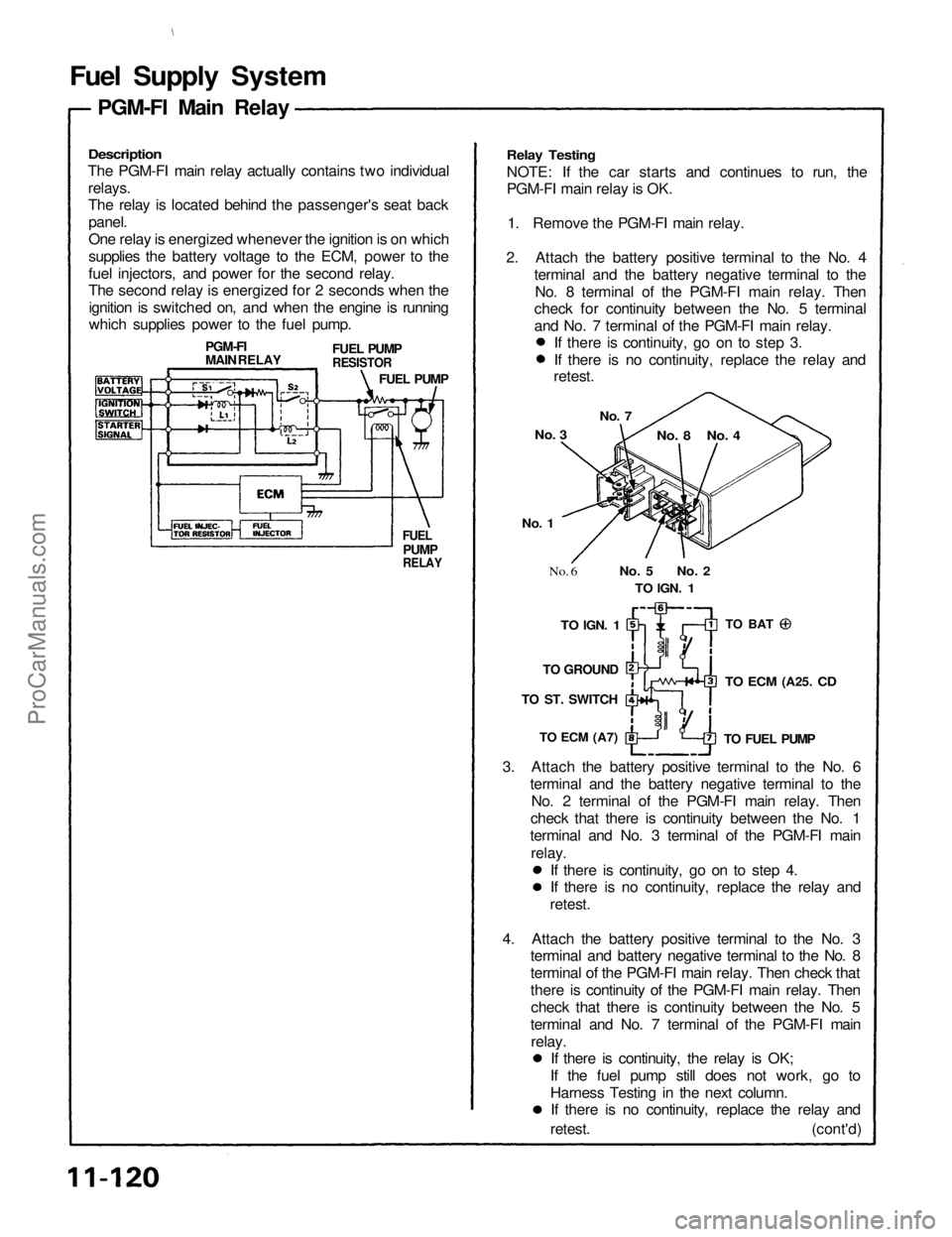
Fuel Supply System
Description
The PGM-FI main relay actually contains two individual
relays.
The relay is located behind the passenger's seat backpanel.
One relay is energized whenever the ignition is on which
supplies the battery voltage to the ECM, power to the
fuel injectors, and power for the second relay.
The second relay is energized for 2 seconds when theignition is switched on, and when the engine is running
which supplies power to the fuel pump.
Relay Testing
NOTE: If the car starts and continues to run, the
PGM-FI main relay is OK.
1. Remove the PGM-FI main relay.
2. Attach the battery positive terminal to the No. 4 terminal and the battery negative terminal to theNo. 8 terminal of the PGM-FI main relay. Then
check for continuity between the No. 5 terminal
and No. 7 terminal of the PGM-FI main relay.
3. Attach the battery positive terminal to the No. 6 terminal and the battery negative terminal to theNo. 2 terminal of the PGM-FI main relay. Then
check that there is continuity between the No. 1
terminal and No. 3 terminal of the PGM-FI main
relay.
FUEL
PUMP
RELAY
FUEL PUMP
RESISTOR
FUEL PUMP
PGM-FI
MAIN RELAY
No. 3
No. 7
No. 8 No. 4
No. 1
No. 6
No. 5 No. 2
TO
IGN.
1
TO BAT
TO
IGN.
1
TO GROUND
TO ST. SWITCH
TO ECM
(A7)
TO ECM
(A25.
CD
TO FUEL PUMP
PGM-FI Main Relay
If there is continuity, go on to step 4.
If there is no continuity, replace the relay and
retest.
4. Attach the battery positive terminal to the No. 3 terminal and battery negative terminal to the No. 8
terminal of the PGM-FI main relay. Then check that
there is continuity of the PGM-FI main relay. Then
check that there is continuity between the No. 5
terminal and No. 7 terminal of the PGM-FI main relay. If there is continuity, the relay is OK;
If the fuel pump still does not work, go to
Harness Testing in the next column. If there is no continuity, replace the relay and
retest. (cont'd) If there is continuity, go on to step 3.
If there is no continuity, replace the relay and
retest.ProCarManuals.com
Page 1120 of 1640
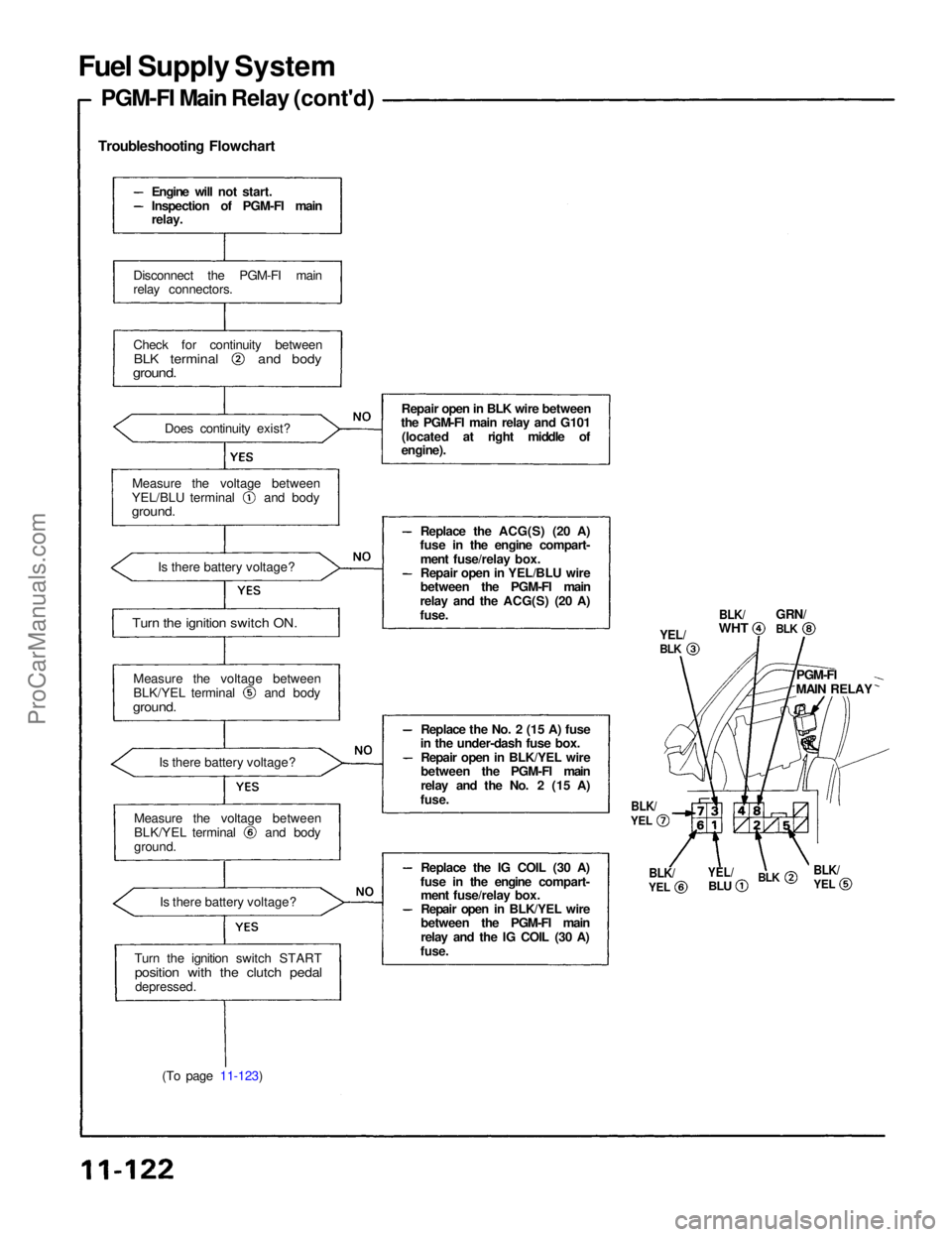
Fuel Supply System
PGM-FI Main Relay (cont'd)
Troubleshooting Flowchart
(To page 11-123)
BLK/
WHT
GRN/
YEL/
BLK
PGM-FI
MAIN RELAY
BLK/
YEL
BLK
YEL/
BLU
BLK/
YEL
BLK/
YEL
BLK
Engine will not start.
Inspection of PGM-FI main
relay.
Disconnect the PGM-FI main
relay connectors.
Check for continuity between
BLK terminal and body
ground.
Does continuity exist?
Measure the voltage between YEL/BLU terminal and body
ground.
Is there battery voltage?
Turn the ignition switch ON.
Measure the voltage between BLK/YEL terminal and body
ground.
Is there battery voltage?
Measure the voltage between BLK/YEL terminal and body
ground.
Is there battery voltage?
Turn the ignition switch START
position with the clutch pedal
depressed.
Repair open in BLK wire between
the PGM-FI main relay and G101
(located at right middle of
engine).
Replace the ACG(S) (20 A)
fuse in the engine compart-
ment fuse/relay box.
Repair open in YEL/BLU wire
between the PGM-FI main
relay and the ACG(S) (20 A)
fuse.
Replace the No. 2 (15 A) fuse
in the under-dash fuse box.
Repair open in BLK/YEL wire
between the PGM-FI main
relay and the No. 2 (15 A)
fuse.
Replace the IG COIL (30 A)
fuse in the engine compart- ment fuse/relay box.
Repair open in BLK/YEL wire
between the PGM-FI main
relay and the IG COIL (30 A)
fuse.ProCarManuals.com